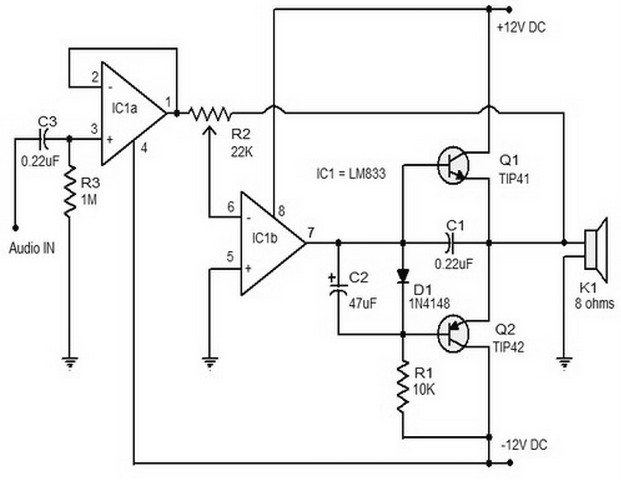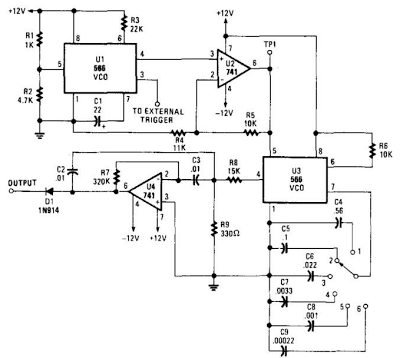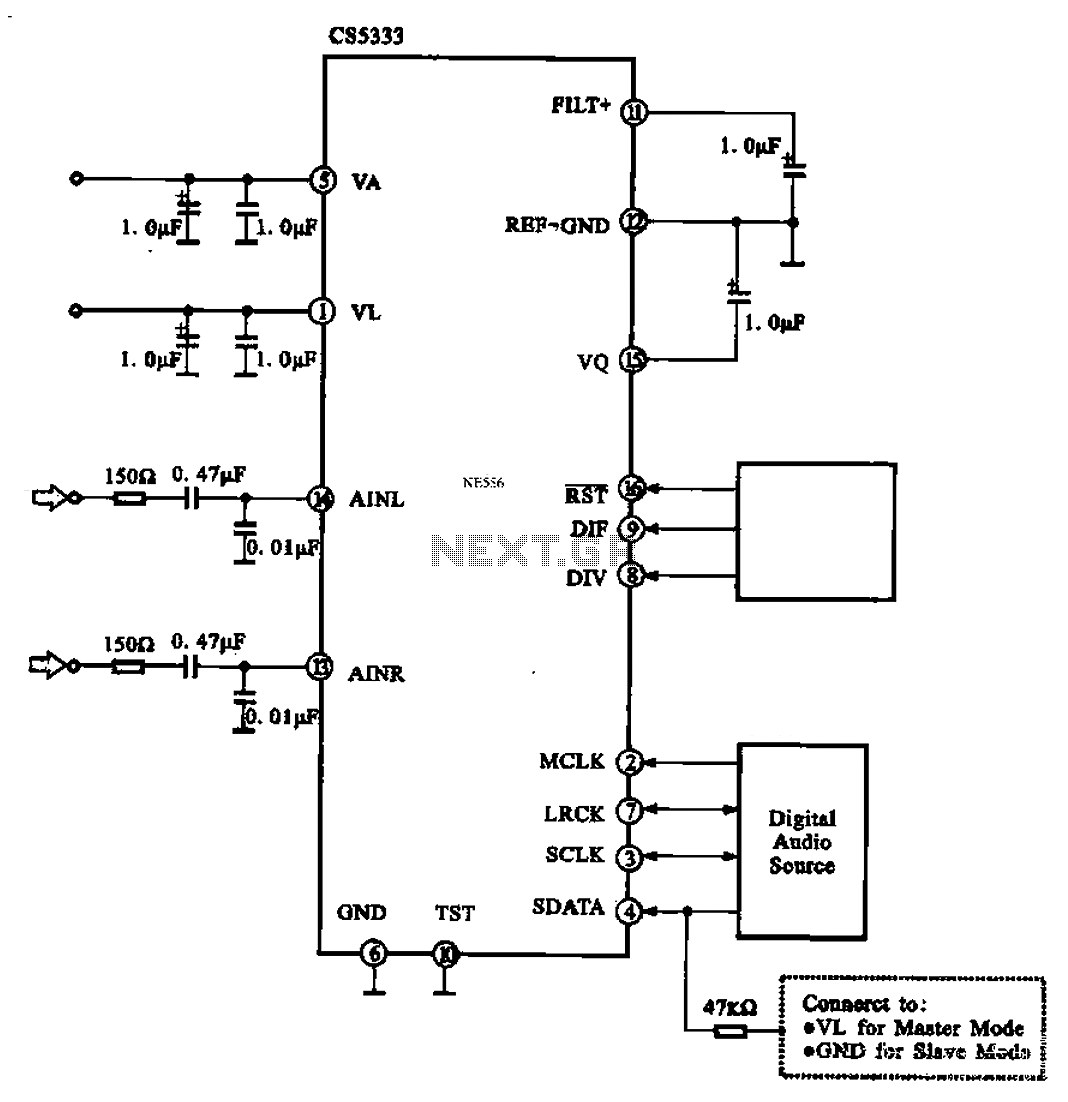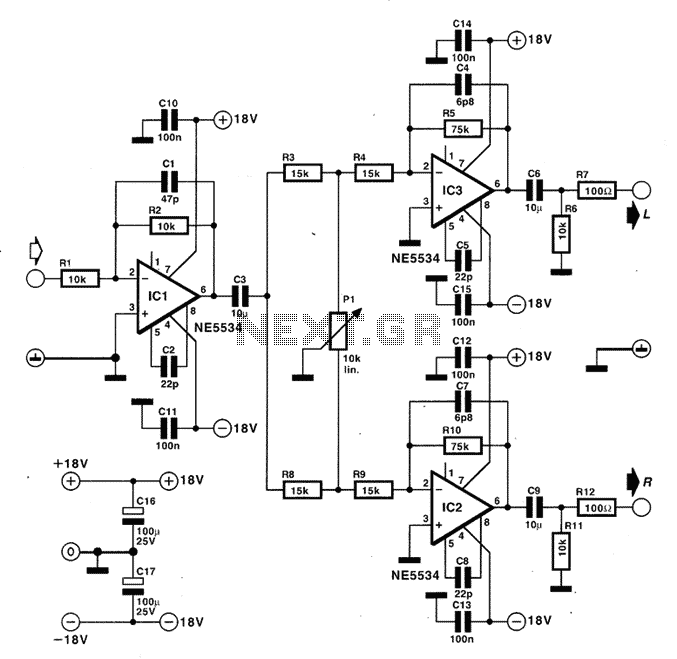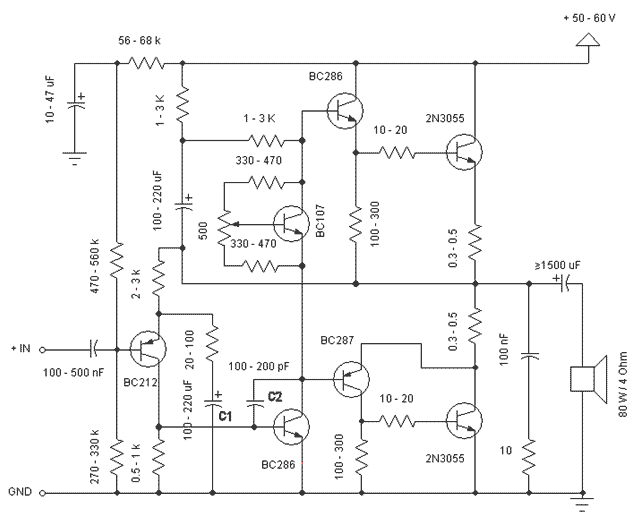
Audio Oscillator

A Wien bridge oscillator generates sine waves with a very low distortion level. It produces zero phase shift at only one frequency (f = 1/2πRC), which becomes the oscillation frequency. Stable oscillation can only occur if the loop gain remains at unity at this frequency. The circuit achieves this control by utilizing the positive temperature coefficient of a small lamp to regulate gain (RF/RLAMP) as the oscillator attempts to adjust its output. The oscillator features four frequency bands ranging from approximately 15 Hz to 150 kHz, with continuously variable frequency within each range using ganged 20 kΩ potentiometers. The circuit draws about 4.0 mA from 9-V batteries, and its output ranges from 4 to 5 V with a 10 kΩ load, with the feedback resistor (RF) set at approximately 5% below the clipping point. The center arm of the 5 kΩ output potentiometer serves as the output terminal. To couple the oscillator to a DC circuit, a capacitor should be inserted in series with the output lead.
The Wien bridge oscillator is a type of electronic oscillator that produces sine wave signals, characterized by its low distortion and stability. The fundamental principle of operation relies on the balance of a resistive-capacitive (RC) network, which sets the frequency of oscillation. The equation f = 1/2πRC reveals that the oscillation frequency is inversely proportional to the product of resistance and capacitance in the circuit.
In this oscillator design, a small lamp is employed to provide automatic gain control. As the output signal varies, the temperature of the lamp changes, which in turn alters its resistance. This feedback mechanism is crucial for maintaining the loop gain at unity, ensuring that the oscillations remain stable. The use of a lamp with a positive temperature coefficient allows for a self-regulating system, where increases in output power lead to increased resistance, thereby reducing gain and preventing distortion.
The oscillator is designed with four distinct frequency bands, enabling operation across a wide range of frequencies from 15 Hz to 150 kHz. This versatility is achieved through the use of ganged 20 kΩ potentiometers, which allow for fine-tuning of the frequency within each band. The circuit's low power consumption of approximately 4.0 mA from a 9-V battery makes it suitable for portable applications.
The output voltage of the oscillator, when loaded with a 10 kΩ resistor, is maintained between 4 to 5 V. The feedback resistor (RF) is strategically set to about 5% below the clipping threshold to optimize performance and minimize distortion. The output is taken from the center arm of a 5 kΩ potentiometer, which serves as an adjustable output terminal.
For interfacing with DC circuits, it is recommended to include a coupling capacitor in series with the output lead. This capacitor blocks any DC component while allowing the AC sine wave to pass through, effectively isolating the oscillator from the connected circuit and preventing any undesired interaction. This design consideration is essential for applications where the sine wave needs to be fed into subsequent stages without affecting the DC operating point of those stages.A Wien bridge oscillator produces sine waves with very low distortion level. The Wien bridge oscillator produces zero phase shift at only one frequency (f = 1/2 P RC) which will be the oscillation frequency. Stable oscillation can occur only if the loop gain remains at unity at the oscillation frequency. The circuit achieves this control by using the positive temperature coefficient of a small lamp to regulate gain (RF/RLAMP) as the oscillator attempts to vary its output. The oscillator shown here has four frequency bands covering about 15 Hz to 150 kHz. The frequency is continuously variable within each frequency range with ganged 20 k ohm potentiometers.
The oscillator draws only about 4. 0 mA from the 9-V batteries. Its output is from 4 to 5 V with a 10 k ohm load and the RF (feedback resistor) is set at about 5% below the point of clipping. As shown, the center arm of the 5 k ohm output potentiometer is the output terminal. To couple the oscillator to a dc type circuit, a capacitor should be inserted in series with the output lead.
(Texas Instruments, Linear and Interface Circuits Applications, Vol 1, 1985, p. 3-15 and 3-16. ) 🔗 External reference
The Wien bridge oscillator is a type of electronic oscillator that produces sine wave signals, characterized by its low distortion and stability. The fundamental principle of operation relies on the balance of a resistive-capacitive (RC) network, which sets the frequency of oscillation. The equation f = 1/2πRC reveals that the oscillation frequency is inversely proportional to the product of resistance and capacitance in the circuit.
In this oscillator design, a small lamp is employed to provide automatic gain control. As the output signal varies, the temperature of the lamp changes, which in turn alters its resistance. This feedback mechanism is crucial for maintaining the loop gain at unity, ensuring that the oscillations remain stable. The use of a lamp with a positive temperature coefficient allows for a self-regulating system, where increases in output power lead to increased resistance, thereby reducing gain and preventing distortion.
The oscillator is designed with four distinct frequency bands, enabling operation across a wide range of frequencies from 15 Hz to 150 kHz. This versatility is achieved through the use of ganged 20 kΩ potentiometers, which allow for fine-tuning of the frequency within each band. The circuit's low power consumption of approximately 4.0 mA from a 9-V battery makes it suitable for portable applications.
The output voltage of the oscillator, when loaded with a 10 kΩ resistor, is maintained between 4 to 5 V. The feedback resistor (RF) is strategically set to about 5% below the clipping threshold to optimize performance and minimize distortion. The output is taken from the center arm of a 5 kΩ potentiometer, which serves as an adjustable output terminal.
For interfacing with DC circuits, it is recommended to include a coupling capacitor in series with the output lead. This capacitor blocks any DC component while allowing the AC sine wave to pass through, effectively isolating the oscillator from the connected circuit and preventing any undesired interaction. This design consideration is essential for applications where the sine wave needs to be fed into subsequent stages without affecting the DC operating point of those stages.A Wien bridge oscillator produces sine waves with very low distortion level. The Wien bridge oscillator produces zero phase shift at only one frequency (f = 1/2 P RC) which will be the oscillation frequency. Stable oscillation can occur only if the loop gain remains at unity at the oscillation frequency. The circuit achieves this control by using the positive temperature coefficient of a small lamp to regulate gain (RF/RLAMP) as the oscillator attempts to vary its output. The oscillator shown here has four frequency bands covering about 15 Hz to 150 kHz. The frequency is continuously variable within each frequency range with ganged 20 k ohm potentiometers.
The oscillator draws only about 4. 0 mA from the 9-V batteries. Its output is from 4 to 5 V with a 10 k ohm load and the RF (feedback resistor) is set at about 5% below the point of clipping. As shown, the center arm of the 5 k ohm output potentiometer is the output terminal. To couple the oscillator to a dc type circuit, a capacitor should be inserted in series with the output lead.
(Texas Instruments, Linear and Interface Circuits Applications, Vol 1, 1985, p. 3-15 and 3-16. ) 🔗 External reference
